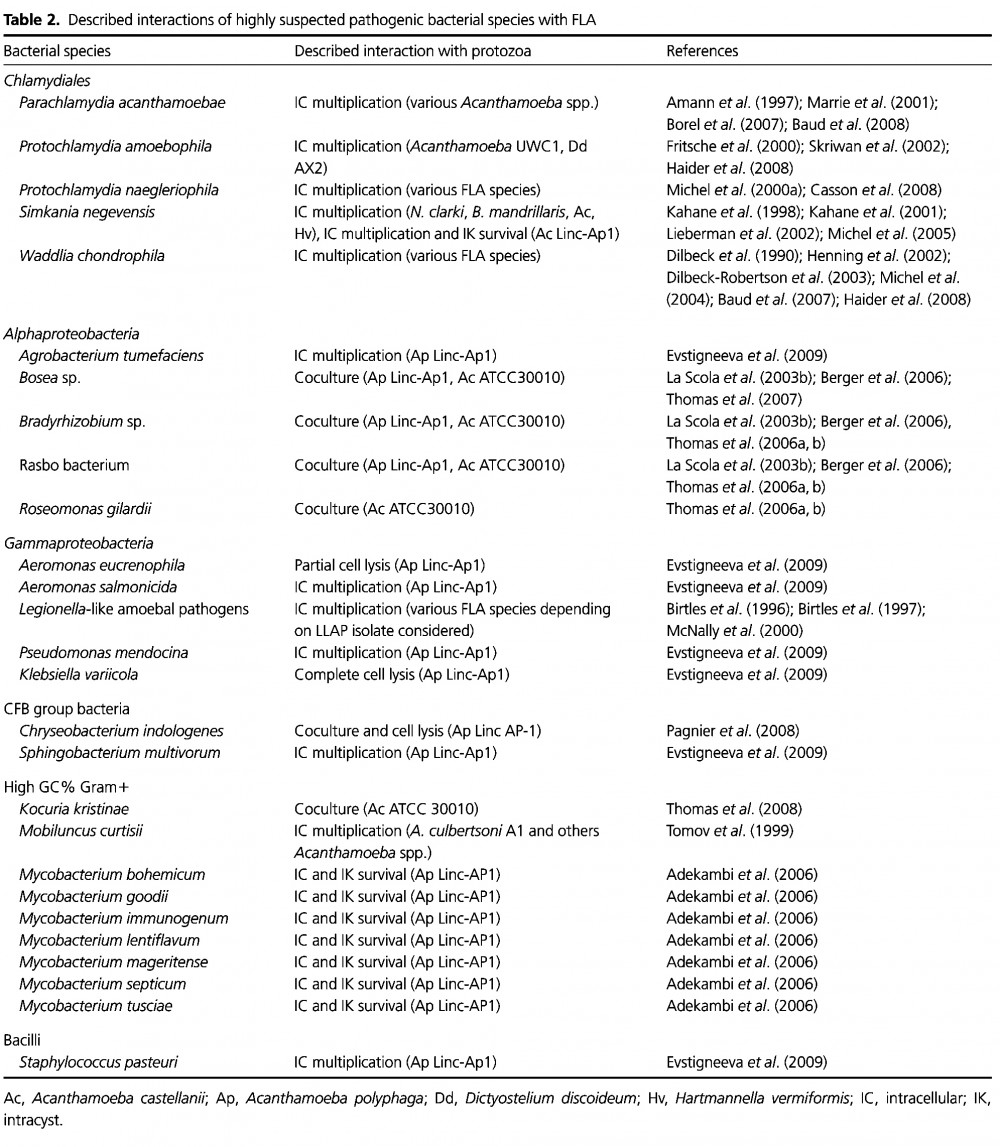(very preliminary – under construction)
Our own lab has done only very preliminary studies of the co-occurrence of various bacterial forms with particular isolates of Acanthamoeba.
An unusually useful review of the interaction of other microorganisms with members of Acanthamoeba is that of Thomas et al. (2010) – FEMS Microbiol Rev 34 (2010) 231–259.
With apologies, I include several of the tables from this paper:
INTERACTIONS WITH PATHOGENIC BACTERIA
INTERACTIONS WITH SUSPECTED PATHOGENIC BACTERIA
INTERACTION WITH OTHER MICROORGANISMS
PROBABLE OBLIGATE INTRACELLULAR ENDOCYTOBIONTS WITH REPLICATION IN ACANTHAMOEBA AND WITH POSSIBLE OR PROVEN PATHOGENIC POTENTIAL
Parachlamydia acanthamoebae [Amman et al. 1997 Appl Environ Microbiol 63, 115-121]. location: dispersed throughout the cytoplasm of trophozoites
Simkania negevensis [Kahane et al., 2001; Appl Environ Microbiol. 67: 4789–4795]. location: within inclusion bodies of trophozoites; within cytoplasm or between cell walls of cysts with retained bacterial viability.
PATHOGENIC EUBACTERIA WITH DEMONSTRATED INTRACELLULAR REPLICATION WITHIN ACANTHAMOEBA.
Acinetobacter baumanii. [Cateau et al. 2011 FEMS Microbiol Lett 319: 19–25]. location: found in vacuoles in the cytoplasm of amoebae trophozoites; not observed in cysts.
Shigella dysenteriae and Shigella sonnei. [Saeed et al. 2009. Arch. Microbiol. 191, 83]
Methicillin-Resistant Staphylococcus aureus (MRSA) [Huws et al. 2006, Environmental Microbiology 8: 1130–1133]. location: within acidic vacuoles of trophozoites
methicillin-sensitive Staphylococcus aureus (MSSA) [Huws et al. 2008. FEMS Microbiol Lett 282: 258–265]. location: within acidic vacuoles of trophozoites
Vibrio cholorae [Van der Henst, et al. 2015. The ISME Journal 10, 897–910]. location: within the contractile vacuole of trophozoites; can persist viably within cysts.
EUBACTERIA WITH ENHANCED REPLICATION IN THE PRESENCE OF (BUT NOT WITHIN) ACANTHAMOEBA.
Listeria monocytogenes [Huws et al. 2008. FEMS Microbiol Lett 282: 258–265].
BACTERIA WITH LIMITED OR NO POTENTIAL FOR INTRACELLULAR GROWTH WITH ACANTHAMOEBA (MAY SERVE AS FOOD SOURCE FOR AMOEBA)
Bacillus cereus [Huws et al. 2008. FEMS Microbiol Lett 282: 258–265].
Enterococcus faecalis [Huws et al. 2008. FEMS Microbiol Lett 282: 258–265].
Enteropathogenic E. coli (EPEC) [Huws et al. 2008. FEMS Microbiol Lett 282: 258–265].



